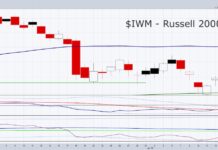 For today’s Market Masters column, I’m going to focus on investor psychology. And more specifically, the value of personal investor confidence. As many of you are fully aware, trading is a difficult endeavor: It is fraught with risk, high stakes volatility, and real-time decisions. One day you are on fire, the next day you are trying to find your groove. And it is how we handle day-to-day successes and failures that ultimately define our monthly P&L and annual performance metrics. In my opinion, managing personal psychology and internal investor confidence is the key to trading longevity and outperformance.
For today’s Market Masters column, I’m going to focus on investor psychology. And more specifically, the value of personal investor confidence. As many of you are fully aware, trading is a difficult endeavor: It is fraught with risk, high stakes volatility, and real-time decisions. One day you are on fire, the next day you are trying to find your groove. And it is how we handle day-to-day successes and failures that ultimately define our monthly P&L and annual performance metrics. In my opinion, managing personal psychology and internal investor confidence is the key to trading longevity and outperformance.
BUT, as the cliché goes, it is far easier said than done. Any time money is involved, our ego perks up and sensitivity levels begin to rise. And it is our job to protect our money from our emotions. “Just give it a few more days…”, “cut it some more slack…”, “I’ll sell next time it hits X per share…”, “just 20 more cents per share…” Yeah, we’ve all been there before and it’s pretty embarrassing in hindsight. It’s as if child-like emotions overtake our sensibilities and the excuses begin to flow like wine. And it is usually these moments in time that show up as red blemishes on our P&L.
There are so many facets to consider when trading: When to initiate a position, when to increase/decrease exposure, when to jump on momentum and high beta, and when to dial back activity, to name a few. However, much of that comes from experience and fundamental/technical valuation analysis. But it is how you set up your approach and execute your plan that really matters. Developing processes and procedures will keep you focused, on track, and disciplined. That said, let’s look at three ways to protect your money… and your investor confidence.
1. Approach – Have a plan
After identifying your investment of choice, make a plan. What is your time frame? Is this a day trade, a swing trade, or an intermediate to long-term investment. Do you want to scale into your trade entry? Or is this a stealth one trade in, one trade out transaction? For more on time frames, read Jeff Wilson’s “Why Time Frames Matter” – it’s a must read.
2. Execution – Execute Your Plan
Within your planned approach, map out entry levels (if scaling), and identify some possible exit levels on the upside should your plan proceed as mapped out. Don’t be afraid to scale out profits on the upside (“scale and trail”) – this allows you to keep skin in the game while taking profits to ensure a “winning” trade. It also allows experienced traders a chance to trade the trend, adding on pullbacks and stopping out just under your trading trend line.
And on the flipside, be sure to firm up your exit strategy and stick to it. Setting stops can save you a lot of pain. It is far too easy to fall prey to emotions and become married to a trade. Be wary of mental actions that may compromise the integrity of your original plan (and tie up cash for prolonged periods). Small losses have little impact on your P&L, whereas bigger losses put you in an emotional hole and behind the performance eight ball. Protect your investor confidence and embrace small losses. Live to trade another day. For more on trading disciplines, read my piece “Five Disciplines for Successful Trading.”
3. Document Your Trades – Keep a P&L or Trading Journal
Accountability is key. As with any competitive endeavor, we get better through repetition, hard work, and a results-oriented focus. A trading journal keeps you in tune with, and accountable for, your performance. It also allows you to form an up close and personal relationship with yourself. To be successful in this business you have to know and understand your actions, emotions, and decision-making process. For more on journaling, read Ross Heart’s “Investors: Why the Past May Hold the Keys to Future Success.”
Thank you for reading this edition of “Market Masters.” I want to personally thank Ryan Detrick, J.C. Parets, Joe Acevedo, and Naufal Sanaullah for their contributions as Market Masters last month. The series is off to a great start. We are excited for next week’s Market Master: Madison Montana. Thanks for reading.
Keep your investor confidence high. Trade safe, trade disciplined.
Twitter: @andrewnyquist and @seeitmarket








